BCS (Body Condition Scoring) is:
- A subjective determination of the amount of fat an animal is carrying
- Fat cover over the loin area between the hip (hook) bone and the last rib is the major area on the animal's body used for condition scoring.
- There is no muscle covering the ends of the short rubs
- therefore, what you feel will be a padding of fat.
Work on Animal's RIGHT side (since the left side is where the rumen is, which will affect the scoring of the animal)

Copyrighted by and attributed to the Queen's Printer for Ontario
Percent Body Fat Present at Different Condition Scores
Canadian Condition Score: 1 (5% BF [body fat]); 2 (15% BF); 3 (20% BF); 4 (27.5% BF); 5 (35% BF)
- Thus, as body condition score increases, body fat increases.
NOTE: Canadian System - based on a 5 point scale
USA System - based on a 9 point scale
Cdn BCS = (USA BC + 1) /2
USA BCS = (Cdn BCS -1) 2
Condition Score = 1
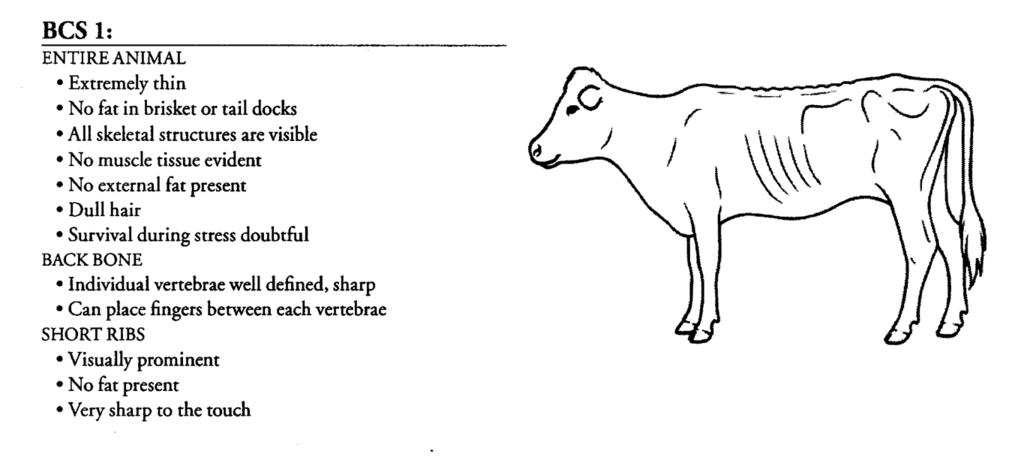
Copyrighted by and attributed to the Queen's Printer for Ontario
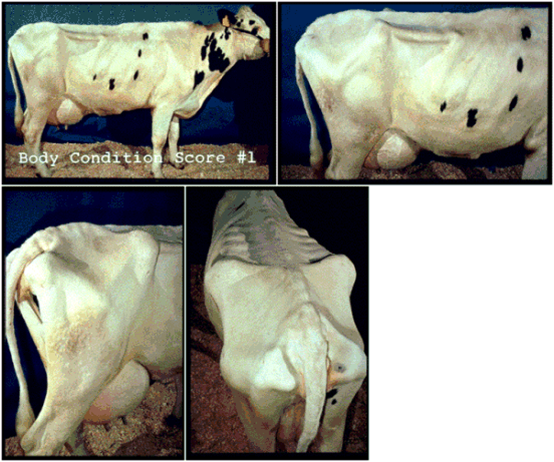
Copyrighted by and attributed to the Queen's Printer for Ontario
This animal is much too thin. Since a lot of the uses of the BCS system is used for reproductive ability, and even feed efficiency, this cow is too thin to have a calf because of lack of body tissue to mobilize to meet the calf's needs. Dystocia is also a problem with thin cows. Her calf will be too small when born, and also the milk quality will be poor since the lack of milk fat that is available, thus this means a small calf that is highly likely to be supplemented with creep feed in order to grow well. She will also come back into heat later when she is in that bad of shape, for the same reasons as described above (lack of body tissue/energy able to be mobilized). This thin cow will also eat a lot because she needs the energy and protein to keep her bodily functions going, and also when it is very cold out since their critical temperature threshold is much higher than a cow with moderate or high BCS. The SPCA and animal rights personnel will also step in at this point because of the concern for malnutrition and sickness is quite high without knowing the real reason why the animal is this thin. This cow pictured above has body fat of 3.8%.
Condition Score = 2
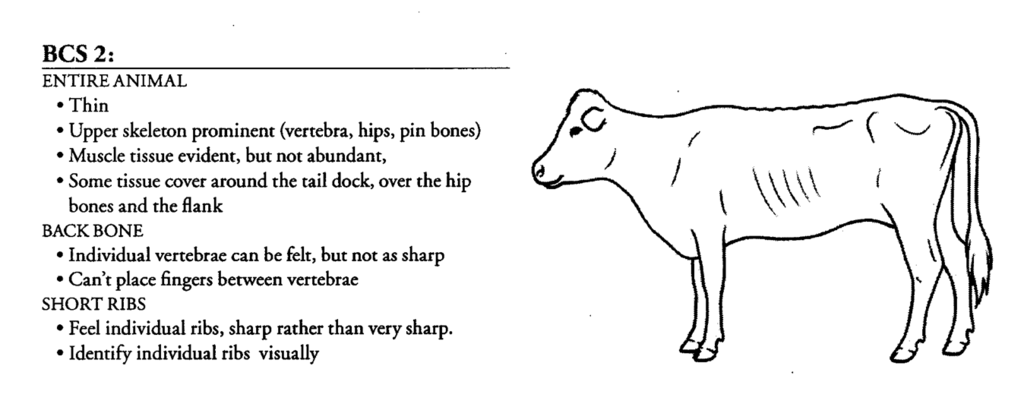
Copyrighted by and attributed to the Queen's Printer for Ontario

Copyrighted by and attributed to the Queen's Printer for Ontario
Though cows are still deemed thin at this point, I can assure you that the SPCA and the animal rights folks won't be as worried and concerned about malnutrition and sickness as the cow with a BCS of 1. She still will have reproductive problems; both calving and breeding back in time for the next calving season. She will also eat more when she is in cold weather, or in times when she is in need of energy. This cow has a body fat content of 11.3%.
Condition Score = 3

Copyrighted by and attributed to the Queen's Printer for Ontario
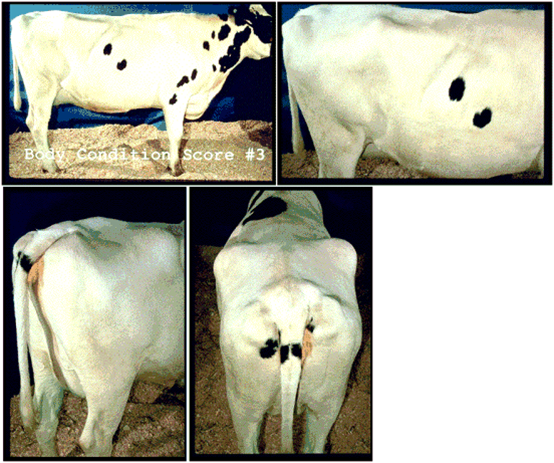
Copyrighted by and attributed to the Queen's Printer for Ontario
This is adequate condition for calving and for all around good feed efficiency. These cows will have success calving by themselves and be in good condition to not be costing too much to feed like the thin cows. They also have a lower critical low temperature (-20 C for normal hided cattle [Angus, for example]) which means that they won't eat a lot when temperatures reach the critical threshold for thinner cows. The fat content of the above cow is 18.9%.
Condition Score = 4

Copyrighted by and attributed to the Queen's Printer for Ontario
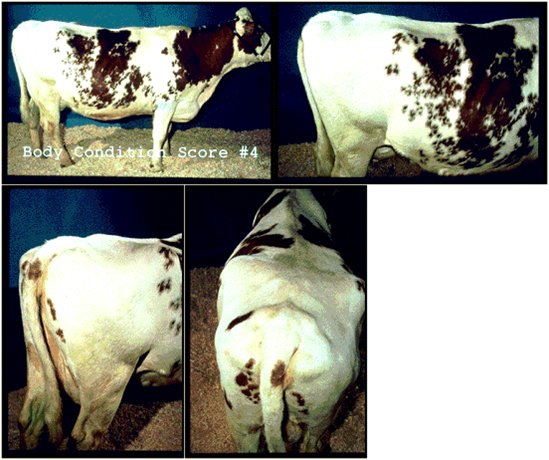
Copyrighted by and attributed to the Queen's Printer for Ontario
This cow is fat. In a system where beef cows are put on a low quality feed to loose weight, this is the condition cows should be in when they go into winter when they are fed a lower quality feed. Fat cows run into milking problems and dystocia, having too much fat around the vulva which poses problems for the calf to pass through during parturition. Fat deposition in the udder also poses problems with milk, because more fat in the udder means less milk is being produced, which leads to a poor growing calf. Beef steers are fed up to this condition score in a backgrounding operation right before they are put on a finisher diet. This cow has a fat conent of 26.4%.
Condition Score = 5

Copyrighted by and attributed to the Queen's Printer for Ontario
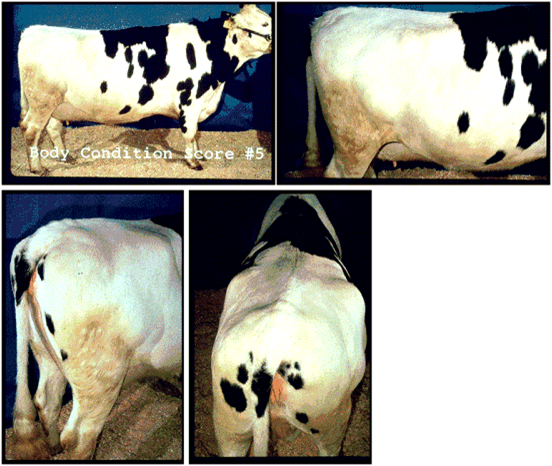
Copyrighted by and attributed to the Queen's Printer for Ontario
This is an overly fat cow, or obese cow. Like I said above, she will have poor milk quality and will very likely have calving problems. Fat cows like this girl are put on a low quality diet in order to lose weight over winter to calve better and to come back into heat on time. She has a lower critical temperature than a normal conditioned cow, in other words she will have the same daily intake at -20 C as at -30 C. Beef cattle on a finisher diet will have a "bigger butt" than this Holstein cow, or a more rounded rear. Carcasses that are overly fat are down-graded severly by our North American slaughter houses because of the amount of fat on the carcass that needs to be trimmed and the high marbling. However, the Asian Kobe beef is a delicacy from cows that are overly fat like this. This cow has a fat content of 33.9%.
When to Condition Score?
-3 times a year is recommended
- Fall pregnancy check or start of winter feeding
- optimal score is 3.0 (though it can go above this)
- At calving:
- Mature cows optimal score is 2.5
- First calf heifers optimal score is 3.0
-30 days pre-breeding
- Optimal score is 2.5
Why Condition Score? Cost Management
- The current cattle industry is forcing us to manage our cost, not just list them
- Winter feeding a beef cow is the largest single cost for a cow-calf operation
- Winter feed costs are approximately 40% of the variable costs per cow per year
- 65 to 75% of the total variable costs per year are feed related
- $1 saving in winter feed costs increases profits by $2.48 for the operation.
How Does BCS Influence Management?
- Build cow condition when feed is cheap
- Harvest the condition you build at different times of the year up to one bale per cow
- Less feed needed for winter with good fall BCS
- Use Cheaper Feed System - Skip-A-Day feeding
- Limit DMI (dry matter intake) in dry cow rations or add straw
- Monitor conditions after harsh periods of weather
- A subjective determination of the amount of fat an animal is carrying
- Fat cover over the loin area between the hip (hook) bone and the last rib is the major area on the animal's body used for condition scoring.
- There is no muscle covering the ends of the short rubs
- therefore, what you feel will be a padding of fat.
Work on Animal's RIGHT side (since the left side is where the rumen is, which will affect the scoring of the animal)

Copyrighted by and attributed to the Queen's Printer for Ontario
Percent Body Fat Present at Different Condition Scores
Canadian Condition Score: 1 (5% BF [body fat]); 2 (15% BF); 3 (20% BF); 4 (27.5% BF); 5 (35% BF)
- Thus, as body condition score increases, body fat increases.
NOTE: Canadian System - based on a 5 point scale
USA System - based on a 9 point scale
Cdn BCS = (USA BC + 1) /2
USA BCS = (Cdn BCS -1) 2
Condition Score = 1

Copyrighted by and attributed to the Queen's Printer for Ontario

Copyrighted by and attributed to the Queen's Printer for Ontario
This animal is much too thin. Since a lot of the uses of the BCS system is used for reproductive ability, and even feed efficiency, this cow is too thin to have a calf because of lack of body tissue to mobilize to meet the calf's needs. Dystocia is also a problem with thin cows. Her calf will be too small when born, and also the milk quality will be poor since the lack of milk fat that is available, thus this means a small calf that is highly likely to be supplemented with creep feed in order to grow well. She will also come back into heat later when she is in that bad of shape, for the same reasons as described above (lack of body tissue/energy able to be mobilized). This thin cow will also eat a lot because she needs the energy and protein to keep her bodily functions going, and also when it is very cold out since their critical temperature threshold is much higher than a cow with moderate or high BCS. The SPCA and animal rights personnel will also step in at this point because of the concern for malnutrition and sickness is quite high without knowing the real reason why the animal is this thin. This cow pictured above has body fat of 3.8%.
Condition Score = 2

Copyrighted by and attributed to the Queen's Printer for Ontario

Copyrighted by and attributed to the Queen's Printer for Ontario
Though cows are still deemed thin at this point, I can assure you that the SPCA and the animal rights folks won't be as worried and concerned about malnutrition and sickness as the cow with a BCS of 1. She still will have reproductive problems; both calving and breeding back in time for the next calving season. She will also eat more when she is in cold weather, or in times when she is in need of energy. This cow has a body fat content of 11.3%.
Condition Score = 3

Copyrighted by and attributed to the Queen's Printer for Ontario

Copyrighted by and attributed to the Queen's Printer for Ontario
This is adequate condition for calving and for all around good feed efficiency. These cows will have success calving by themselves and be in good condition to not be costing too much to feed like the thin cows. They also have a lower critical low temperature (-20 C for normal hided cattle [Angus, for example]) which means that they won't eat a lot when temperatures reach the critical threshold for thinner cows. The fat content of the above cow is 18.9%.
Condition Score = 4

Copyrighted by and attributed to the Queen's Printer for Ontario

Copyrighted by and attributed to the Queen's Printer for Ontario
This cow is fat. In a system where beef cows are put on a low quality feed to loose weight, this is the condition cows should be in when they go into winter when they are fed a lower quality feed. Fat cows run into milking problems and dystocia, having too much fat around the vulva which poses problems for the calf to pass through during parturition. Fat deposition in the udder also poses problems with milk, because more fat in the udder means less milk is being produced, which leads to a poor growing calf. Beef steers are fed up to this condition score in a backgrounding operation right before they are put on a finisher diet. This cow has a fat conent of 26.4%.
Condition Score = 5

Copyrighted by and attributed to the Queen's Printer for Ontario

Copyrighted by and attributed to the Queen's Printer for Ontario
This is an overly fat cow, or obese cow. Like I said above, she will have poor milk quality and will very likely have calving problems. Fat cows like this girl are put on a low quality diet in order to lose weight over winter to calve better and to come back into heat on time. She has a lower critical temperature than a normal conditioned cow, in other words she will have the same daily intake at -20 C as at -30 C. Beef cattle on a finisher diet will have a "bigger butt" than this Holstein cow, or a more rounded rear. Carcasses that are overly fat are down-graded severly by our North American slaughter houses because of the amount of fat on the carcass that needs to be trimmed and the high marbling. However, the Asian Kobe beef is a delicacy from cows that are overly fat like this. This cow has a fat content of 33.9%.
When to Condition Score?
-3 times a year is recommended
- Fall pregnancy check or start of winter feeding
- optimal score is 3.0 (though it can go above this)
- At calving:
- Mature cows optimal score is 2.5
- First calf heifers optimal score is 3.0
-30 days pre-breeding
- Optimal score is 2.5
Why Condition Score? Cost Management
- The current cattle industry is forcing us to manage our cost, not just list them
- Winter feeding a beef cow is the largest single cost for a cow-calf operation
- Winter feed costs are approximately 40% of the variable costs per cow per year
- 65 to 75% of the total variable costs per year are feed related
- $1 saving in winter feed costs increases profits by $2.48 for the operation.
How Does BCS Influence Management?
- Build cow condition when feed is cheap
- Harvest the condition you build at different times of the year up to one bale per cow
- Less feed needed for winter with good fall BCS
- Use Cheaper Feed System - Skip-A-Day feeding
- Limit DMI (dry matter intake) in dry cow rations or add straw
- Monitor conditions after harsh periods of weather
